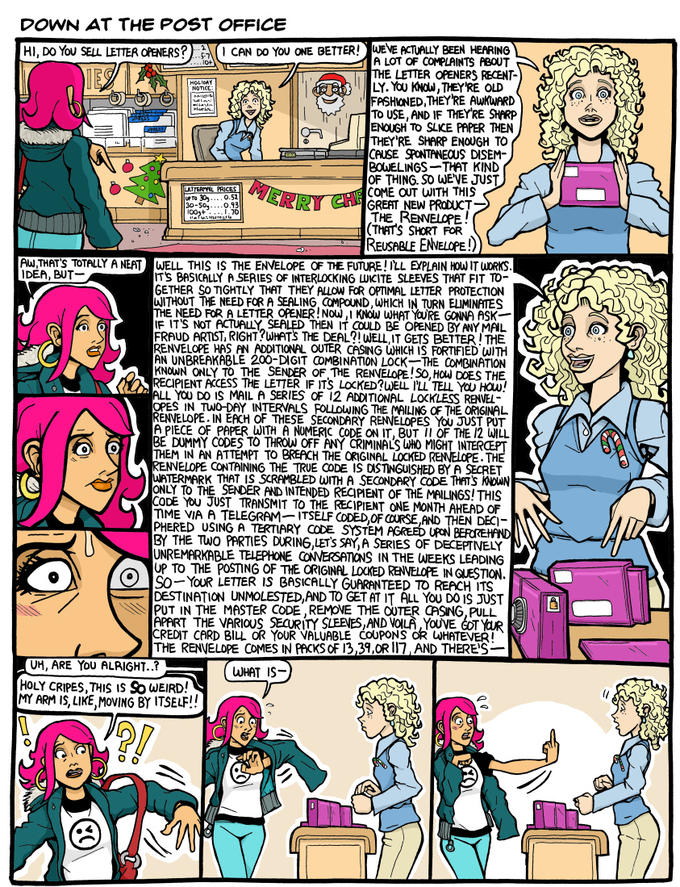About
Wall of Text refers to needlessly long text posts that are often found without line or paragraph breaks. Walls of text can be found in a wide range of online conversations from spam emails and webcomic dialogue to blog posts and comment sections.
Origin
One of the earliest mentions of the phrase “wall of text” appeared in the title of a spam message posted on three unrelated newsgroups on November 21st, 1996 by a company named Valucard International. The post, “Wall of text with subtle picture,” was shared on alt.books.phil-k-dick[1], alt.sci.time-travel[2] and alt.ascii-art[3] with the summary “ascii art disguised as screenful of mumblejumble” and a keyword, “oh my god.”
Etaoin Shridlu opened the book to where his thumbnail had randomly parted
the pages and began reading from the center of the page but noticed something
strange about the pattern of the rivulets of space around the words and soon
had lost all comprehension of the literal meaning of the passage when a picture…
clearly asserted itself in the apparently meticulously intricate typing which
was simultaneously a long unpunctuated nonsensical run on sentence and yet a
photograph perfectly halftoned into dots shaped as letters of the alphabet
no doubt generated by a cybernetic system that creates fractal branched
sentences which never end but instead sort of parenthesize and go for a ways
and then change course usually by going into detail in a tangential sort of
stackpush that never pops but instead keeps zooming in yet another level
each line or so like an infinite inwards motion that doesn’t even need
punctuation and takes the reader on a one-way trip forwards into
progressively refined images much like the incredible shrinking man or
Fantastic Voyage except that it just keeps on going so actually the effect
is more like the colored oilslick breakdowns in 2001 and if you could get
the wave action of the text into just the right peristaltic contractions in
sync with the eye and mind of the audience it could get pretty awesome like
nanotech cities living on the bark of redwood trees in undulating valleys of
forests on nonspherical fiberspace membranes extruded by femtopicotek
nested-space 3.2-dimensional manifolds “bigger at the small end of the
scale” provided you have senses which don’t peter out when things get subtle
thus allowing you to encode information in the very borderlines of its very
existence thus relying on the viewer’s idiosyncrasies more than on his
common-ness because things which are on the edge of not being there at all
are going to probably excite a set of simultaneous responses which don’t
triangulate or intersect or agree or synergize in an unambiguated crisp
singleness and are also somewhat partial and even flickering or dynamic or
changing rapidly with time which requires their mind(s) to choose from a
bifurcating multiplexing divergence of (mildly) resonant rapidly-evolving
attractors forming a ghostly community of evaporatory cooperative “temporary
friends” sharing fleeting memories because a localized continuity of thought
is maintained on more than one level
hAIry 14:41 tue21nov96 “fractal fuzzybushes of worlds: godhead datastructor”
------------------------------------------------------------------------------
May the best hallucination win.
I want a God who takes responsibility for His mistakes.----------------------------------------------------------------------------
In Literature
Though the phrase may not have entered online usage until 1996, a similar concept has been used in the literary device known as stream-of-consciousness since the 18th and 19th centuries, when authors would write paragraphs that continue on for pages at a time.[4] This technique was used several times in James Joyce’s 1922 novel Ulysses[5], as highlighted in the final chapter “Penelope.” Also known as Molly Bloom’s Soliloquy[6], the chapter consists of eight sentences, one of which is 4,391 words long. This was the longest sentence in English literature until 2001, when a 13,955-words long sentence was published in Jonathan Coe’s novel The Rotters’ Club.[7]
Spread
In 2002, walls of text was mentioned on UseIt.com’s list of that year’s Top Ten Web-Design Mistakes[8], which described this type of text as intimidating, boring and hard to read. On August 31st, 2005, the first definition for the phrase was added to Urban Dictionary[9] and two years later, it was added to Uncylopedia[10], which presents the entry in one lengthy paragraph instead of the normal article format. In 2010, it was added to the Online Slang Dictionary.[14]
Bloggers also use the phrase to denote especially verbose posts on Tumblr[11] and LiveJournal[12], which yields more than 137,000 search results for “wall of text.” In April 2008, walloftext.net[13] was registered as a secondary domain name to someone’s personal blog, which was updated with wordy posts until February 2012. The phrase can also be used to refer to a negative trait that appears in webcomics, when artists would write in unnecessarily long dialogues that encroach on the comic’s art.[16] Subnormality[15] (shown below), a webcomic blog launched in 2007, is known for its lengthy dialogue scenes.
Search Interest
Search volume for “wall of text” peaked in September 2008, coinciding with the creation of the TV Tropes[4] page for the phrase.
External References
[1] alt.books.phil-k-dick – Wall of text with subtle picture
[2] alt.sci.time-travel – Wall of text with subtle picture
[3] alt.ascii-art – Wall of text with subtle picture
[4] TV Tropes – Wall Of Text
[5] Wikipedia – Ulysses (novel)
[6] Wikipedia – Molly Bloom’s Soliloquy
[7] Wikipedia – The Rotter’s Club
[8] UseIt – Top Ten Web-Design Mistakes of 2002
[9] Urban Dictionary – Wall of Text
[10] Uncyclopedia – Wall of Text
[11] Tumblr – Posts tagged “wall of text”
[12] LiveJournal – Search results for “wall of text”
[14] The Online Slang Dictionary – Wall of Text
[15] Wikipedia – Subnormality
[16] Bad Web Comics Wiki – The Wall of Text




